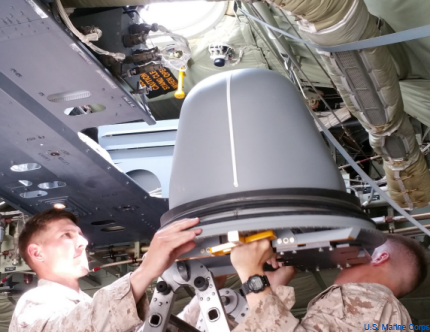Hatch-mounted satellite system keeps Marines updated in-flight
The system provides network access, real-time video and other tools for crisis-response teams right up until they arrive on a battlefield.

Marines install HMSAS in the hatch of a C-130 Hercules.
The military puts a lot on emphasis on situational awareness—the idea that expeditionary forces arriving on a battlefield should know what they’re getting into. But that’s been a problem when forces have a long flight between when a mission is planned and when they arrive, because their aircraft hasn’t been connected to the tactical network, depriving them of intelligence updates and other information. Meanwhile, enemy forces aren’t static; they’ll move. Battlefields change.
The Marine Corps is solving that problem with a hatch-mounted satellite communications system for its aircraft that provides access to the tactical classified network, secure voice and chat, and streaming ISR video, as well as access to the unclassified network and the public Internet. So they’ll have a clear view of the battlefield right up to the time they disembark.
“It’s a powerful combat capability in a very small package,” Basil Moncrief, head of the team fielding the system, said in a release.
Moncrief leads the Command Control and Communications team for the Special Purpose Marine Air-Ground Task Force, which has fielded the system—the Hatch-Mounted Satellite Communication Antenna System, or HMSAS—on three continents within four months of receiving funding.
According to the Marine Corps Systems Command, commanders saw an urgent need for in-flight communications for crisis response units within the U.S. Africa and U.S. Central Commands. The units needed mission-planning and command and control capabilities while on long trips aboard KC-130J Hercules transport aircraft, which, like the tilt-rotor MV-22 Osprey often employed on missions, are usually not connected to a network.
MHSAS, which can be installed in an aircraft’s hatch in as little as 30 minutes, is a satellite communications system with integrated cryptography that connects with ruggedized laptops and tactical command-and-control software. It “provides all command, control and mission planning capability a crisis response team could want,” Moncrief said.
The system was developed through an accelerated acquisition program that, the Marines said, still put a lot of emphasis on safety and testing. Some critical work on integrating cryptography and tactical software, and in assuring secure access to Defense department networks, was done at the Networking On-The-Move lab at Point Loma, Calif. After tests at bases in Spain and Kuwait, MHSAS is now being deployed.
In-flight communications is something the military has been making progress on. Last year, the Army began installing its Enroute Mission Command Capability—which it calls a “flying command post”—on C17 aircraft, giving commanders the ability to plan missions while providing rapid-response teams with real-time video of their upcoming drop zones.